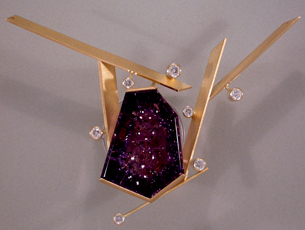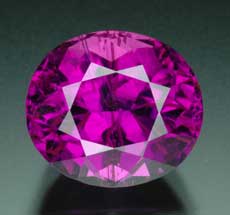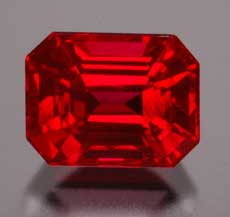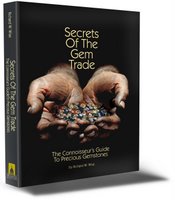
Possibilities for holiday giving
By Richard W. Wise, G.G.
© 2006

During our summer show, I took the opportunity to select one of the most interesting of the Michael Dyber gem sculptures to make into a necklace and turned it over to Douglas Canivet. The center stone pictured is a 42.25 carat ametrene. This gem material shows both yellow and purple in the same crystal. It comes from only one mine, Anahi in Boliva. I like the combination of zoning and rich color and the sensitive way Michael integrated the natural features of the gem into a pleasing composition.
The necklace was completely hand fabricated. For those of you who don’t know, hand fabrication is the old method of hand making. We use the same methods as those pictured on the tombs of
The construction, exclusive of design time, took more than sixty hours, that’s a week and a half for a master craftsman of Doug’s caliber. We used 35.3 penny-weight (dwt.) of 18k gold. Penny weight is an old unit of measure, 20 dwt. to the ounce so a bit over an ounce and a half. The eight diamonds; 1.08 carat total weight of D-E, VS color ideal cut stones set in handmade tubes. Ideal cuts are perfectly proportioned stones that deliver between 92-98% total light return. They are dazzlers!
Notice the joinery, how the angles at which the gold links join create a juxtaposition of shape and plane that compliment the center sculpture. Note how the diamonds appear to float. The gold has a sandblasted finish. This allows the gems visual room to work.Craftsmanship:
Contemporary hand fabricated jewels look simple. Because the designs are clean without excessive ornamentation you get the idea that they are simpler to make than say Victorian pieces with all the filagree. Not true! Most handmade jewelry is put together with gold solder and gold solder will not "fill in" empty space so every join must be fitted perfectly. Fine cabinetry is a good analogy. Its very much like building a desk or cabinet. Every angle requires a solder joint. It took about eight separate pieces just to make the setting for the center stone. In this necklace everywhere you see an angle there is a join and if the fit is not perfect you will see lumps, holes and porosity at the joint. In such a "simple" design there is no where to hide your mistakes. A master's hand is evident not only in what you see but also in what you don't see.
Handmade is better made:
Is there a difference between hand made and mass-manufactured. Most mass-manufactured jewelry is designed by people who have never worked in gold. The design is drawn or created on a computer then mastered in wax. The element of dialogue, the give and take between the artist and his materials together with the fine eye and sensitive mark of the hand is always missing. Then, of course, it is the only one! Does uniqueness have value? Today, much custom design is done with CAD software. A craftsman can tell a CAD designed piece a mile away. It is yet another step removed from the hand. To me CAD designed jewelry has a sterile soul-less quality.
Other Possibilities:
May I show you some of the newest additions to my gem collection? These are stones sourced on my recent trip to The Orient. These are one of a kind gems that to my eye are extraordinary.
Padparadscha Sapphire:
There seems to be a lot of interest in Padparadscha sapphire. As I define it in my book; Secrets Of The Gem Trade, Padparadscha, the word is a corruption of the Singhalese padma raga or “color of the Lotus”. Padparadscha is a pinkish orange to orangey pink sapphire. Here is the important point it must be a delicate hue. The Sri Lankans prefer as stone with a bit more pink than orange. This stone embodies the essence of the term. It is a 3.98 carat natural stone with no enhancement or treatment of any kind. It is has a flower-petal soft quality.
important point it must be a delicate hue. The Sri Lankans prefer as stone with a bit more pink than orange. This stone embodies the essence of the term. It is a 3.98 carat natural stone with no enhancement or treatment of any kind. It is has a flower-petal soft quality.
True un-monkeyed-around-with padparadscha sapphires is one of nature’s great rarities. This is one of the finest stones I have seen in my career. The shape makes it an excellent candidate for a pendant but if you will accept my advice, make a ring. Rings are for people who love gems and want to stop and admire.
Purple
Rare and beautiful, until the new find of cuprian tourmaline from
I am told that the stones from  heated and those that cannot.
heated and those that cannot.
This one is a visually pure purple. It weighs 8.14 carats. In the magnified image you can see straight growth tubes but without magnification the stone is eye-flawless viewed face-up. It is a visually pure purple with no evidence of gray and it stands up well in both natural and incandescent lighting.
Fancy Color Diamonds; A Sweet Suite:
I tried to resist this delectable suite of orange and purple fancy color diamonds but I failed. The language of the GIA certificate calls the center a “Yellow-Orange” meaning that the two hues exist in fairly equal proportions. To me it is a yellowish-Orange, a true tangerine with all the warmth and richness of the sun kissed fruit. The two vivid purple-pinks are pure of hue with no gray or brown to either dull or muddy the hue. All three understated, elegant and beautifully cut.
exist in fairly equal proportions. To me it is a yellowish-Orange, a true tangerine with all the warmth and richness of the sun kissed fruit. The two vivid purple-pinks are pure of hue with no gray or brown to either dull or muddy the hue. All three understated, elegant and beautifully cut.
A
This ruby is a 2.05 carat emerald cut gem. What is a “gem”. In the gem trade, this is the appellation reserved for the crème de la crème, the finest of the fine. Everything, color, cut, clarity and crystal must be outstanding for the gem type and here it is.
“Asking to see the pigeon’s blood is like asking to see the face of God.”
Anonymous Burmese Trader
Love that quote but the truth is not quite so mysterious. “Pigeon’s blood” is a pure medium dark red with a touch (10-15%) blue that when mixed with the red reads as purplish. As an old Burmese jeweler explained it; the blue is cancelled out its compliment, the rich yellow of high carat gold leaving the gem a visually pure scarlet when set.
We have a number of fine rubies as well as fine handmade originals, antique jewelry and gemstones pictured on our website: www.rwwise.com . Please take a look and if you see something you like call me at 800.773.0249 or 413.637.1589 if you live in
 Consider Secrets Of The Gem Trade, The Connoisseur’s Guide To Precious Gemstones. Now in PAPERBACK for only $26.95 at our website or slightly higher at Amazon.com www.secretsofthegemtrade.com.
Consider Secrets Of The Gem Trade, The Connoisseur’s Guide To Precious Gemstones. Now in PAPERBACK for only $26.95 at our website or slightly higher at Amazon.com www.secretsofthegemtrade.com. done a marvelous job of this first book,
a monumental work, a tour de force...
My recommendation: Buy this book”
Charles Lewton-Brain, Orchid




1 comment:
Dear Sir:
I have just discovered your blog, and am thoroughly impressed. Very informative and very interesting. You have a new fan.
I suppose it's a bit silly of me to argue with you about whether CAD/CAM is soulless or not. You are an expert in gems, I'm an expert in computer-aided design. And several years separates the dates each of us left school and started work as jewellers. (It also doesn't help that I grew up with a desktop computer.)
Nevertheless, I can't help but feel your argument against CAD echoes of the same comments I used to hear back when I started working in real-time computer graphics almost a decade ago. Most people (even some computer graphics programmers) would tell me that all design created by computers was sterile and lifeless.
Given the limits of the technology at the time, I can't say I blame them. But this is a bit like looking at the Model T and scorning the idea that an automobile could ever outrace a horse. Like any newly developed tool, it simply required refinement. And it was early visionaries who saw beyond the current technology's limitations, and pushed CAD progressively more and more towards what it could be-- an augmentation for the human hand. CAD offered a chance for craftsmen to add the potential of perfection to intuitive work. And like typography software before it, its potential for opening up radical new design possibilities is as revolutionary as it is thus far unexplored.
Some people still insist this tool has limitations, and that it will never replace the human hand. They're right, it won't. But it was never intended to. The goal of CAD, ironically, is to achieve imperfection. And towards this, it has come a long way.
Post a Comment